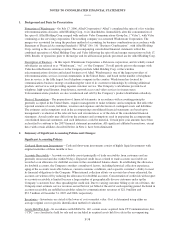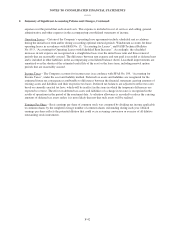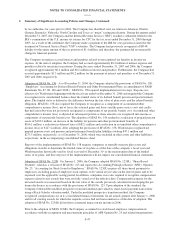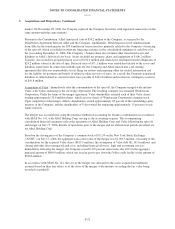Windstream 2007 Annual Report Download - page 133
Download and view the complete annual report
Please find page 133 of the 2007 Windstream annual report below. You can navigate through the pages in the report by either clicking on the pages listed below, or by using the keyword search tool below to find specific information within the annual report.
NOTES TO CONSOLIDATED FINANCIAL STATEMENTS
2. Summary of Significant Accounting Policies and Changes, Continued:
by tax authorities for years prior to 2004. The Company has identified state tax returns in Arkansas, Florida,
Georgia, Kentucky, Nebraska, North Carolina and Texas as “major” taxing jurisdictions. During the quarter ended
December 31, 2007, the Company and the Internal Revenue Service (“IRS”) reached a settlement related to the
IRS’s examination of the U.S. income tax returns for CTC for the tax years ended December 31, 2000 through
2003. As a result of the settlement, the Company made a payment to the IRS for a tax position claimed for the
treatment of Universal Service Fund (“USF”) subsidies. The Company had previously recognized a FIN 48
liability for the entire amount of the tax position of $1.4 million, and therefore, the payment did not materially
change its financial position.
The Company recognizes accrued interest and penalties related to unrecognized tax benefits in income tax
expense. At the date of adoption, the Company had accrued approximately $0.2 million of interest expense and
penalties related to uncertain tax positions. During the years ended December 31, 2007 and 2006, the Company
recognized approximately $0.4 million and $0.2 million in interest and penalties. Furthermore, the Company had
accrued approximately $1.5 million and $0.2 million for the payment of interest and penalties as of December 31,
2007 and 2006, respectively.
Adoption of SFAS No. 158 - As of December 31, 2006, the Company adopted the provisions of SFAS No. 158,
“Employers’ Accounting for Defined Benefit Pension and Other Postretirement Plans, an amendment of FASB
Statements No. 87, 88, 106 and 132(R)”. SFAS No. 158 required implementation in two steps. Step one was
effective for Windstream beginning with the fiscal year ended on December 31, 2006 and required the Company
to recognize in its consolidated balance sheet the funded status of its defined benefit pension and postretirement
plans. The funded status is defined as the difference between the fair value of plan assets and the related benefit
obligation. SFAS No. 158 also required the Company to recognize as a component of accumulated other
comprehensive income (loss), net of taxes, the actuarial gains and losses and the prior service costs and credits
that had arisen but were not previously recognized as components of net periodic benefit cost. Accumulated other
comprehensive income (loss) is adjusted in subsequent periods as these amounts are recognized into income as
components of net periodic benefit cost. The adoption of SFAS No. 158 resulted in a reduction of prepaid pension
assets of $103.2 million, an increase in the liability for pension and other postretirement benefits of
$106.1 million, a reduction in deferred taxes of $82.1 million and a reduction in accumulated other comprehensive
income (loss) of $127.2 million. After adopting the provisions of SFAS No. 158, Windstream recognized net
prepaid pension assets and pension and postretirement benefit plan liabilities totaling $47.1 million and
$275.5 million, respectively, as of December 31, 2006, which were included in other assets and other liabilities,
respectively, in the accompanying consolidated balance sheet.
Step two of the implementation of SFAS No. 158 requires companies to annually measure plan assets and
obligations in order to determine the funded status of its plans as of the date of the company’s fiscal year-end.
Windstream has historically used its fiscal year-end of December 31st as the measurement date of the funded
status of its plans, and thus step two of the implementation will not impact our consolidated financial statements.
Adoption of SFAS No. 123R - On January 1, 2006, the Company adopted SFAS No. 123(R), “Share-Based
Payment”, which is a revision of SFAS No. 123 and supercedes Accounting Principles Board (“APB”) Opinion
No. 25, “Accounting for Stock Issued to Employees”. SFAS No. 123(R) requires all share-based payments to
employees, including grants of employee stock options, to be valued at fair value on the date of grant, and to be
expensed over the applicable vesting period. In addition, companies were also required to recognize compensation
expense related to any awards that were not fully vested as of the effective date. Compensation expense for the
unvested awards was measured based on the fair value of the awards previously calculated in developing the pro
forma disclosures in accordance with the provisions of SFAS No. 123. Upon adoption of the standard, the
Company followed the modified prospective transition method and valued its share-based payment transactions
using a Black-Scholes valuation model. Under the modified prospective transition method, the Company
recognized compensation cost in its consolidated financial statements for all awards granted after January 1, 2006
and for all existing awards for which the requisite service had not been rendered as of the date of adoption. The
adoption of SFAS No. 123(R) did not have a material impact on net income in 2006.
Prior to the adoption of SFAS 123(R), the Company accounted for stock-based employee compensation in
accordance with the recognition and measurement principles of APB Opinion No. 25 and related interpretations.
F-47
























